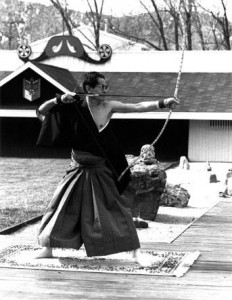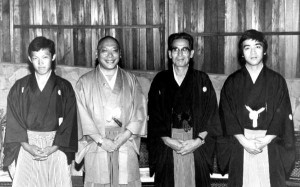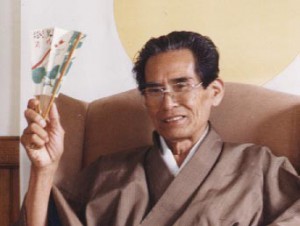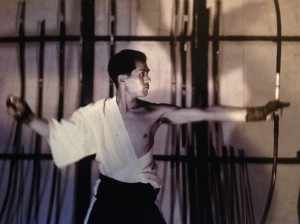Thursday
Featured StoriesWarrior Tribute to Onyumishi Kanjuro Shibata XX
Born in Kyoto, Japan in 1921, Shibata began his Kyudo training at the age of eight. At a young age he also began training in bowmaking with his grandfather, Kanjuro Shibata XIX, in the family workshop. In 1959, upon the death of Kanjuro XIX, he officially became Kanjuro Shibata XX and assumed the duties of Imperial Bowmaker to the Emperor of Japan.
Perhaps you are thinking that neutrality is some sort of spiritual goal. This is not the case. Looking deeply at our hearts is the aim of spiritual practice. Kyudo practice is not neutral. Kyudo practice is about balance. Balance is not the same as neutrality. Neutrality only seeks the middle. In kyudo practice we are equally aware of the left, the right, the middle, all of it. How long have you been practicing? Once more again, practice. This is my hope.
~ Kanjuro Shibata Sensei
 Shibata Sensei was the master of Taiyusha Kyudojo practice hall in Kyoto (founded in 1883) until its closure in 1991. In addition to making bows for warriors and nobility, the Shibatas also made hama-yumi (sacred bows) used in Shinto and Buddhist rituals. They were also heads of Kyoto Bowmaker’s Guild for many generations. During the Meiji Restoration, the Shibata lineage was appointed the Bowmaker to the Emperor of Japan, whose most important duty is producing the Goshimpo-yumi which are enshrined at the Grand Imperial Shrine at Ise and replaced every twenty years.
Shibata Sensei was the master of Taiyusha Kyudojo practice hall in Kyoto (founded in 1883) until its closure in 1991. In addition to making bows for warriors and nobility, the Shibatas also made hama-yumi (sacred bows) used in Shinto and Buddhist rituals. They were also heads of Kyoto Bowmaker’s Guild for many generations. During the Meiji Restoration, the Shibata lineage was appointed the Bowmaker to the Emperor of Japan, whose most important duty is producing the Goshimpo-yumi which are enshrined at the Grand Imperial Shrine at Ise and replaced every twenty years.
In Japan, Shibata Sensei became concerned that his students were too fixated on merely hitting the target, and were treating kyudo as a sport rather than a meditative art. He felt they were becoming too competitive. Shibata thus represents a view of kyudo different from the All Japanese Kyudo Federation (ZNKR) and Japanese Budo Association. Rather than as a meditative art, ZNKR promotes kyudo as a traditional budo art combining equally both physical and mental development. These differences led Shibata Sensei to exclude his tradition from the official Japanese budo associations.
 In 1980 Shibata Sensei came to the United States to teach kyudo to the Shambhala community, at the invitation of Vidyadhara the Venerable Chogyam Trungpa Rinpoche. Together they founded Ryuko Kyudojo (Dragon-Tiger Kyudo Practice Hall) in Boulder, where he established permanent residence in 1985. The Sakyong, Jamgon Mipham Rinpoche, studied for many years with Shibata Sensei and became president of Ryuko Kyudojo.
In 1980 Shibata Sensei came to the United States to teach kyudo to the Shambhala community, at the invitation of Vidyadhara the Venerable Chogyam Trungpa Rinpoche. Together they founded Ryuko Kyudojo (Dragon-Tiger Kyudo Practice Hall) in Boulder, where he established permanent residence in 1985. The Sakyong, Jamgon Mipham Rinpoche, studied for many years with Shibata Sensei and became president of Ryuko Kyudojo.
One is not polishing one’s shooting style or technique, but the mind. The dignity of shooting is the important point. This is how Kyudo differs from the common approach to archery. In Kyudo there is no hope. Hope is not the point. The point is that through long and genuine practice your natural dignity as a human being comes out. This natural dignity is already in you, but it is covered up by a lot of obstacles. When they are cleared away, your natural dignity is allowed to shine forth.
~ Kanjuro Shibata
Shibata Sensei traveled and taught extensively, and founded Zenko International, with over 25 Kyudo practice groups in the United States, Canada and Europe. Sensei officially retired from his duties as Imperial Bowmaker in 1994 in favor of his son, but with the support of his wife Carolyn, was active in teaching until his death. He performed purification ceremonies at the Sakyong’s Enthronement and Wedding. The Amaterasu-mikami shrine at Shambhala Mountain Center was constructed at his request and under his guidance.
 “Shibata Sensei was an exemplar of warriorship,” writes Shambhala Mountain Center Director Michael Gaynor. “In the last year of his life, he visited Shambhala Mountain Center on a number of occasions in response to a request from the staff to teach warriorship and revitalize the practice of Kyudo at the mountain center. Despite his obvious frailty and need for oxygen at the higher elevation, he came and shared his profound teachings with us. He also invited the staff to his dojo in Boulder, to take first shot with him. This was a warrior for whom there was never a moment of holding back.”
“Shibata Sensei was an exemplar of warriorship,” writes Shambhala Mountain Center Director Michael Gaynor. “In the last year of his life, he visited Shambhala Mountain Center on a number of occasions in response to a request from the staff to teach warriorship and revitalize the practice of Kyudo at the mountain center. Despite his obvious frailty and need for oxygen at the higher elevation, he came and shared his profound teachings with us. He also invited the staff to his dojo in Boulder, to take first shot with him. This was a warrior for whom there was never a moment of holding back.”
Please take a moment and share your comments and tributes below.






Oct 28, 2013
Reply
Like an arrow piecing the heart. Farewell to a gentle and kind master.
Oct 28, 2013
Reply
On Sensei´s first trip to Germany (and Europe) he gave practitioners of Vajradhatu/Shambhala the opurtunity to come in contact with kyudo and so with him and his beautiful young wife Marcia.
I became the coordinator for the first 2 weeks in that Sensei presented kyudo in Marburg. It was wonderful and for dinner we were out in a little restaurant.He wanted every one to sing a song. We came from different countries and communication was easy and lovely. Of course we invited him to come back and he did and had many students.
Oct 27, 2013
Reply
This link connects to a video of Shibata XX Sensei’s Cremation Ceremony, the song that you hear is Sensei singing about a flock of geese, “Gun”…one or two may fly away from the V -shaped flock in the sky and another one or two will join it in its arrow shaped course across the sky. It’s a very old Samurai song.The location is Shambhala Mountain Center. The “V” also has a special meaning to the Dorje Kasung: . . . __
Video courtesey of Greg Smith
https://www.youtube.com/watch?v=1FTRNGxq0rM
Oct 25, 2013
Reply
I could not go to Colorado because I am caregiver for my husband who fell on his forehead and suffered a massive stroke eight years ago. That was known to both Carolyn and Sensei, because both have supported my path since my husband’s stroke cut through my ability to go out and practice Kyudo. Even after our answering machine died an electronic death, I kept it so I could still hear greetings from Sensei via Carolyn after my husband’s stroke at age 52.
What I remember today, among other memories, is Sensei giving a demonstration at the close of an intensive Kyudo program at Karme Choling. Someone was in a rush to cover a bale of straw as the target for his demonstration and only had thick muslim at hand and not the usual cotton.
Sensei offered his demonstration but each of two ya bounced off the covered bale and both fell on the platfrom, side by side, in perfect form as if they had penetrated the covered bale. All eyes (students present) were fixated on the ya. How could they fall in the same place, side by side? We had released ya that did not penetrate the target and they went every which way. But these, they were identical in the way they fell on the platform!
Well, that was a brief moment of contemplation.
When Sensei completed the form, he roared that the bale was not properly covered and we as students suffered and cowered. No one really knew who covered the bale of straw, but we all knew we would never do it that way again. The focus on the covering for the straw bale made us forget about trying to get our ya to fall side by side like Sensei’s if they didn’t penetrate the target, which was yet another teaching.
I am all jumbled up and not as clear seeing as others who have posted or been present for Sensei’s sukhavati and cremation.
I would be in Colorado today and this last week, but I can no longer travel. Worse, I cannot call students of Kyudo to grieve because they are all out in Colorado.
I burst into tears soon after the hour for the cremation today even though I was not paying attention to the time. I worked with the Heart Sutra mantra as instructed, but I miss so much being able to offer my last shot at the cremation.
Most honorable Sensei~
I remain forever your most loyal student.
~Vivi Spicer, Miyako Iba of Washington, DC, USA
and Shambhala Meditation Centre of Washington, DC, USA
P.S. Kyudo practice helped me finish Ngondro for Vajrayogini practice, but no one really wants to know that.
~vcs
Oct 25, 2013
Reply
Sensei was a hero to many of us, and it’s devastating to think of him finally gone from the earth, though he was going slowly for years. Even so, he would make the grueling trip from Boulder to Dechen Chöling year after year— a tremendous gift to his kyudo students here. As well, kyudo often ran parallel to Family Camp, so many parents and children had their first contact with a living master-warrior when Sensei would extend invitations to kyudo exhibitions, or to the yearly ceremony at the Kami Tree. At the Rites of Passage, Sensei’s shout would startle each child into a fresh mind right before they received a ceremonial arrow from him.
The fact that there is a Kami Tree at Dechen Chöling is entirely Sensei’s doing. He ordered one particular tree to be enshrined—standing in for all the magnificent old trees there—and the next day taught his kyudokas what they needed to know for construction and decoration of the shrine. For the ceremony itself, students, DCL staff and Shambhala Europe representatives got instruction more or less as it was taking place.
Shibata Sensei’s passing marks a serious diminishment of old-time Japanese feeling within Shambhala. From the early 1970’s through the end of the century, Shambhala forms, calligraphy, vocabulary – “hai!” – and even mode of dress were strongly influenced by the cultural elegance of Japan, embodied in his person. The Way of the Bow, the Way of Flowers and the Way of Tea continue in our world, led very capably by Westerners, as is fitting. But Sensei’s bone-marrow-deep sincerity and loyalty, his crisp attention to ritual detail, his Zen flair—all will be sorely missed. Those of us who were moved by him will now have to maintain this dignity without his humbling example. It’s a worthy challenge. It would be a fitting tribute. I will certainly be trying.
Oct 24, 2013
Reply
The LOCATION for Shibata Sensei’s ceremony is the BOULDER SHAMBHALA CENTER at 1345 Spruce Street, Boulder. We will begin at 7:00a.m. sharp. Please plan to arrive by 6:45a.m.
We will then proceed directly to Shambhala Mountain Center in Red Feather Lakes for the Cremation ceremony which will begin at 11:30a.m.
Oct 24, 2013
Reply
Tonight as I sit and reflect on the three years ,I had the honor of being a student of Shibata Sensei,words cannot really express ,the emotions I am feeling.I have visions of a man reflecting great strengths,through his words of wisdom,song,teachings of his much loved kyudo,and just being in his presence,could give you so much comfort and love.My, how he loved to gather his flock together around him and slowly look into our eyes and smile.We would wait with excitement for a story or just a few words to take away with us,as they were always golden.He could answer a question usually with just a word.I hope in some way that I can keep up my practise of kyudo in a way that I can make a contribution to all, that I’m around whether it maybe in shooting or making the tea for a group,always keeping his memory with me and knowing that it will be passing it along to another generation,his heart felt teachings.
Tonight I want to celebrate his life and keep his memories and teachings close to my heart,it will give me great comfort to know that our teacher has just moved on,in his walk,as a warrior.
Oct 24, 2013
Reply
Dear O-Sensei,
It has been a wonderful journey over the past 30 years with you.
If you are listening, please take my words into your heart.
Now our father has left us for a time and I have a feeling that our journey is not yet over altogether.
A great warrior has assured that our path extends much further into the future.We will not likely see another
like him in the generations to come; he may have been the very last of his kind. I remember above all Shibata Sensei XX tying the loose hakama straps of my 9 year old son Dugan years ago. Among so many other accomplishments in establishing a genuine practice lineage in the West, he empowered each of us over the years to become genuine human beings with pure, unshakable confidence in our own basic goodness.
Many of us will soon begin the journey which comes at life’s end. By then another yet unknown, younger warrior who is now among us will preside over our kyu no michi into the future, bearing the blazing , luminous torch of this heart polishing lineage. Of this our precious kyudo master, who arrived among us like an arrow from ancient times, can be assured.
We love you , and will always remember that you said repeatedly, ” Hello is NOT goodbye!”
Oct 24, 2013
Reply
In my memory Sensei is in a way unfathomable and the same time very human both on and off the platform. Sensei introducing the special meal chant, stealing cutlery or a teapot in a restaurant where he did not like the service, performing the shihobarai ceremony, singing the Goose-song, ordering me to get up and sit at the far end of the table, shedding tears for his friend Kobun Chino Roshi, showing the children how to prepare riceballs for a daytrip, presiding over rites of passage, sharing his sweets with everybody, pointing his stick with a terrifying face, taming his dog with a look. This summer supporting the annual kyudo seminar in Dechen Chöling via skype from his bed. Such loyalty is unmatched. My thoughts are with Carolyne, the family and kyudo family.
Oct 24, 2013
Reply
A great privilege indeed to have had this great master, Shibata Sensei, in our Vajradhatu/Shambhala midst for so many years. My all-time favorite line of Sensei’s was part of my earliest Kyudo training in the early 80s. I believe it was in reponse to the western competitiveness that was “trying” to creep into Kyudo practice.
Sensei said (with total conviction): “It is none of your business where the arrow goes.”
It is a great tribute to Sensei’s students and companions that he had such an extraordinary long life. May his legacy live long and prosper.
Oct 24, 2013
Reply
The Dorje Kasung had an opportunity to study the Hagakure at the Zenko Kyudojo twenty or so years ago with the recently passed Onyumishi Shibata Kanjuro XX. Hagakure, or Hidden (by) Leaves, is a famous Japanese discussion of warriorship in the Bushido (Samurai) tradition. It suggests that the warrior should always be prepared for death, or to regard himself already dead. Sensei told us that it was from the Hagakure tradition that his people came from. It was a privilege to have been taught by you, Sir.